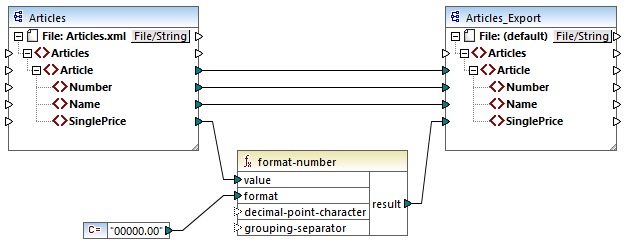Mapping Scenarios
Mapping scenarios can differ on the following criteria: (i) sources and targets and (ii) complexity of mappings. Different data structures can be used as sources and targets: e.g., XML Schema, an XML file with an assigned schema, databases etc. To find out more about the acceptable formats of sources and targets, see Mapping: Sources and Targets.
The complexity of mapping designs is illustrated in but not limited to the following scenarios:
•Mapping one source to one target. For more information about this type of mapping, see Tutorial 1.
•Merging multiple data sources into one target. For more information, see Tutorial 2.
•Filtering the data in such a way that only a subset of this data is mapped to the target file. See Tutorial 3.
•Mapping the structure and content of the source to the target file. See Tutorial 4.
Regardless of the technology you work with, MapForce typically determines automatically the structure of your data or suggests supplying a schema for your data. MapForce can also generate schemas from a sample instance file. For example, if you have an XML instance file but no schema definition, MapForce can generate it for you. Thus, MapForce makes the data inside the XML file available for mapping to other files or formats. To find out more about the basic terms and features of MapForce, see Mapping Fundamentals and User Interface Overview.
Projects (Professional and Enterprise editions)
For easier access and management, you can organize your data mapping designs into mapping projects. In addition to generating code for individual mappings within the project, you can generate program code for entire projects.
Customization options
In MapForce, you can completely customize not only the look and feel of the development environment, but also various settings related to each technology and mapping component type. For example:
•When mapping to or from XML, you can choose (i) whether to include a schema reference, or (ii) whether the XML declaration must be suppressed in the output XML files. You can also choose the encoding of the generated files (for example, UTF-8).
•When mapping to or from databases, you can define settings such as the time-out period for executing database statements. It is also possible to choose whether MapForce should use database transactions, or whether it should strip the database schema name from table names when it generates code.
•In the case of XBRL, you can select the structure views that MapForce should display: the Presentation and definition linkbases view, the Table Linkbase view, or the All concepts view.
Examples
The examples below illustrate mapping designs that use the same (XML-to-XML mapping) and different (Database-to-XML mapping) types of source and target structures. Both mapping examples are simple in that only one data source and one data target are used. To find out about more advanced mappings, tasks and procedures, see Advanced Mapping Scenarios.
XML-to-XML mapping
The example below shows a mapping design that uses the same type of source and target components (XML). Connecting source and target nodes (e.g., Number) instructs MapForce to read the data from the source nodes and write them to the target nodes. The mapping uses the format-number function that converts the value of the SinglePrice element to a string and writes this converted value to the SinglePrice target element.

Database-to-XML mapping
Professional and Enterprise editions allow you to use databases as mapping sources and targets. When you set up a database connection in MapForce, you can flexibly choose a database driver and a connection type (ADO, ADO.NET, ODBC, or JDBC) depending on your existing infrastructure and data mapping needs. Additionally, you can visually build SQL queries, use stored procedures, and query a database directly (support depends on the database type, edition and driver). The example below illustrates how database data is mapped to an XML file:
